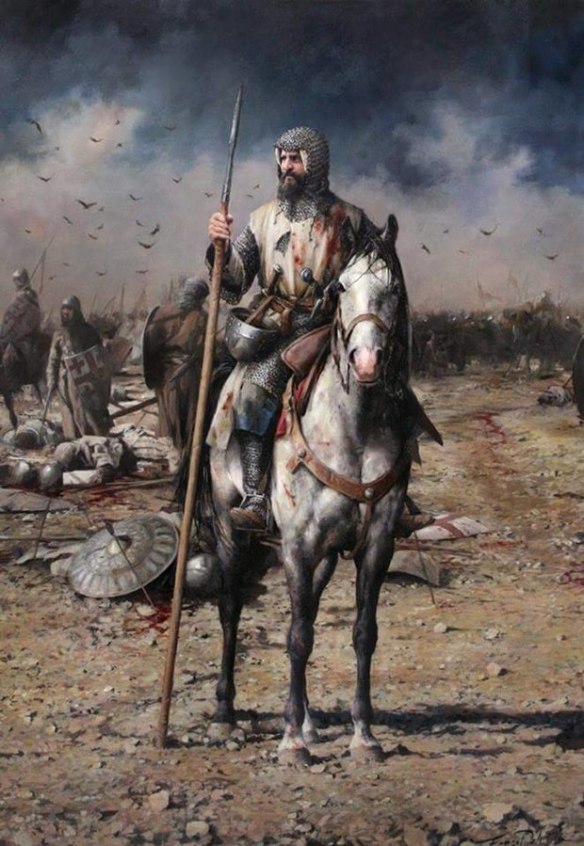Queen of the kingdom of Georgia between 1184 and 1213. The eldest daughter of King Giorgi III (1156-1184), Tamar was made a co regent in 1178 and succeeded her father six years later. Her accession, however, was not without difficulty. Powerful lords took advantage of the passing of the king to reassert themselves. Despite internal dissent, Georgia turned into a powerful kingdom and enjoyed major successes in its foreign policy. Between 1193 and 1194 Tamar led the Georgian army into southwestern Transcaucasia, and in 1195 she defeated a large Muslim coalition in the battle at Shamkhor (in modern Azerbaijan), allowing her to expand her sphere of influence. In 1203 she achieved another triumphant victory when a massive coalition of Muslim states, led by the sultan of Rum, was crushed at Basiani. Georgians annexed Ani, Arran, and Duin between 1201 and 1203, and in 1209 the combined armies captured the emirate of Kars (now in Turkey) while the mighty Armen-Shahs, the emirs of Erzurum and Erzinjan (also now in Turkey), and the north Caucasian tribes became the vassals. Georgian influence also ex tended to the southern coastline of the Black Sea, where the empire of Trebizond (now in Turkey), a Georgian vassal state, was established in 1204. Tamar then carried war into Azerbaijan and advanced as far as Tabriz, Qazvin, and Khoy in northern Iran between 1208 and 1210. In 1212 she successfully campaigned against mountaineers in the Caucasus. These victories brought Georgia to the summit of its power and glory, establishing a pan-Caucasian Georgian empire stretching from the Black Sea to the Caspian and from the Caucasus Mountains to Lake Van.
Tamar’s political and military successes were accompanied by an equally impressive religious and cultural expansion throughout Asia Minor and the Holy Land. The stability and strong central authority of Tamar’s reign facilitated the growth of towns and the development of trade and crafts. Tbilisi, with a population of some 100,000, became one of the largest cities in the Middle East and a center of regional and international trade linking China, Central Asia, and Europe. Tamar’s reign also stimulated a renaissance of Georgian sciences and art. Numerous classical Georgian scholarly and literary works such as Amiran-Darejaniani, Abdulmesia, and Tamariani were produced both within Georgia and abroad while the arts of illumination of manuscripts and miniature painting reached their zenith. Georgian monasteries, generously sponsored by the queen, flourished throughout the Holy Land and Asia Minor. Finally, Shota Rustaveli’s epic poem, The Knight in the Panther’s Skin, was dedicated to Tamar; it remains the greatest cultural achievement of Georgia in that age.
References and Further Reading Metreveli, Roin. 1992. Tamar. Tbilisi, Georgia: Metsniereba. Qadagidze, Marine. 2001. Tamar mepis droindeli matiane: Tskhovreba Mepet mepeta Tamarisi. Tbilisi, Georgia.
Aftermath of the Battle of Didgori in 1121, during the Georgian-Seljuk wars. The battle saw the Georgians decisively defeat the invading Seljuks.Close neighbours to the dour Armenians, the Georgians were remarkably extrovert and cheerful, a difference which has been attributed to the superior local wines. Their standards were windsock lions tethered by the upper lip, the mouth held open with wire. The Georgians’ uncompromising attitude to Islam is shown by their inscribing the title “Sword of the Messiah” on their coins in Arabic to make sure the message got across, by marching on pilgrimage to Jerusalem with banners displayed without paying tribute and daring Arab rulers to stop them, and by naming a border fort “Kiss My Backside” to commemorate the reply to a Turkish summons! Initially devoted to charging with the lance and using bows mainly for hunting, they are later depicted emphasising bow rather than lance. This change took place in the early 12th century under Seljuq and Cuman influence. Georgian foot were armed with spear or bow. All had a round shield and most wore lamellar armour. Georgian military strength in the 12th century depended heavily on large numbers of Cumans settled in depopulated parts of the country. Other nomads, such as Serirs, Lesghs, Suans and Jikils, also served. After 1245, the country broke up into competing kingdoms, with only brief nominal reunions.
